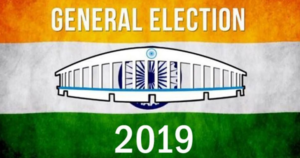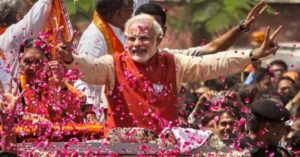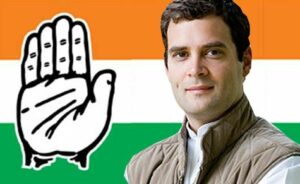OdishaPlus Bureau

In the 2019 Lok Sabha elections, the BJP has won 303 seats, 21 more than its 2014 tally. The saffron spray across all over northern and western India is similar to 2014. With gains in new areas, the BJP vote share nationally has risen from 31% to approximately 38%. Of the 60 crore votes polled in this election, more than 23 crore have gone to the BJP.
Here are the key takeaways of this election:
Referendum?
Like in 2014, the BJP’s stunning victory revolved around Narendra Modi. The strategy of contesting a presidential-style election paid off again. But, this election was also a referendum on Modi.
UP Unharmed
In UP, the BJP has almost repeated its performance of 2014. Despite the gathbandhan of the SP, BSP, and RLD, BJP is down by only nine seats from its tally of 71 the last time. These losses were more than made up by its gains in new areas.
New Areas
The BJP is no longer a small player in West Bengal and Odisha. In Bengal, it has won over 40% of the popular vote and 18 seats. In Odisha, it has won 38% of the vote and eight seats, up from the 22% vote and one seat in 2014. In Telangana, it has made a small but significant gain of four seats.

Negative Campaign
While the 2014 campaign was a campaign of hope, the 2019 campaign was in large part negative. The BJP reminded the people of what might happen if it was not voted back. In 2014, Modi sold India a vision for the future. This time round, he solicited votes for continuation of his good work.
Cultural Nationalism
In becoming the first non-Congress Prime Minister to return with an increased majority after a full five-year term, Modi has established that 2014 was not an isolated election. The verdict is a clear approval by the people of BJP’s idea of ‘cultural nationalism’ and ‘national pride.’
Same Choice
Given the sweep of the BJP’s victory, it is clear that both villages and towns have voted alike. The BJP’s core message seems to have been accepted with equal enthusiasm everywhere. The nationalist passion that followed the Balakot airstrikes worked to numb the pain of the rural economic distress.
No Mandal
The results in UP and Bihar signal that the Mandal politics is reaching its dead end. The fact that the SP got only five seats in UP, the JD(S) just one in Karnataka, and the RJD none at all in Bihar, suggests that even core support bases of the Mandal parties could be slipping.
Patidar Politics
The BJP’s successes in Haryana, Gujarat, Rajasthan, and Maharashtra seem to have redefined the boundaries of the politics of the Jats, Patidars and Marathas, who have led big agitations against BJP governments over the last several years.
Unemployment Issue
The sweeping mandate suggests that the campaign around the major issue was not forceful enough to influence the result. One possible explanation is that many voters, while being hurt by the lack of jobs, had enough faith in Modi that he would eventually solve the unemployment problem.

Rahul’s Failure
With just 52 Lok Sabha seats for the Congress, it is only a petty improvement from 44 seats in 2014. Seniors are no longer willing to accept Rahul as a leader, and his leadership is seen by party workers as “family entitlement”. All of Rahul’s jibes at Modi haven’t impressed the voters.
Dynasty Politics
With Rahul and Scindia losing elections, voters have rejected dynasts. Modi’s constant flagging of “naamdaars” has put the dynasts on the defensive. Similarly, only Mulayam and Akhilesh appear to be retaining their seats. The narrative people have bought into is that no constituency can be treated as a family fiefdom.
Passing Bills
The new government will now find it easy to push through Bills in Lok Sabha. But it may still have to negotiate in Rajya Sabha, where it is short of majority. The BJP has 73 members of its own and, along with allies, about 100 in the 250-member Upper House. In Modi’s first term, the government was handicapped for this lack of numbers in Rajya Sabha and pushed certain laws as Money Bills. The BJP will wait till it gets majority in the RajyaSabha for important legislations.
Weak Opposition
With a weak opposition, the government will have an advantage. YSR Congress, TRS and BJD, which will have double-digit strength in the new Lok Sabha will have lesser say.
Troubled States
The BJP’s huge majority will give it a psychological edge in attracting independent legislators and those from smaller parties in states where it has numbers to present a viable alternative to the existing government. In MP, the BJP has 109 MLAs compared with 114 of the Congress. In Karnataka, it is the single largest party with 104 members. The Congress-JD(S) alliance has 115 MLAs.
Economic Reforms
Although the BJP had an absolute majority of its own in Modi’s first term, but it failed to push through fundamental reforms in areas such as land, labour and privatization. The new mandate opens up possibilities to take bold decisions backed by strong economic justification.
Big challenges
The primary challenge will be to arrest the economic downslide, revive private investment and boost consumption demand. The first step will be to clean out the financial sector which is reeling under a severe NBFC liquidity crisis and lack of bank credit.
External Affairs
Mending relations with neighbors Pakistan and China will not only bring stability to the region, but will also help the economy. The new government will also have to find the way out of a scary global recession, the US-China trade war, imposition of sanctions on Iran, and uncertainties over Brexit.



























